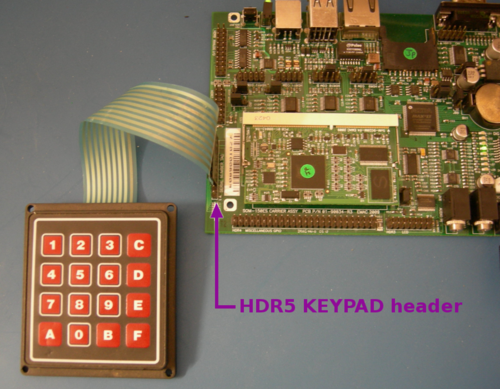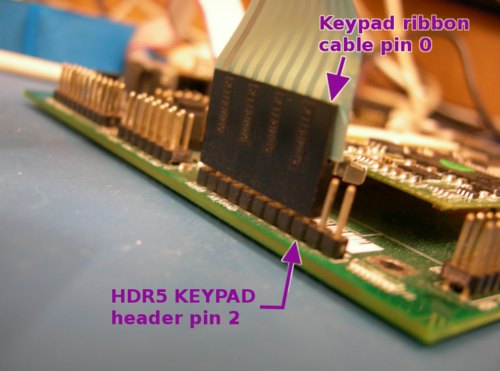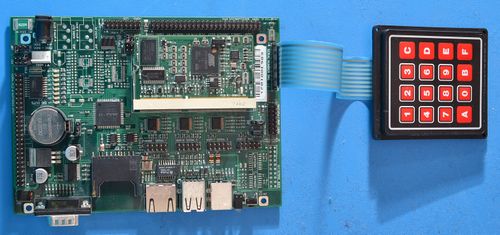Difference between revisions of "Example getkey"
(→Usage Example. Displaying the Matrix Presently Associated with the Keypad) |
(→Usage Example. Displaying the Matrix Presently Associated with the Keypad) |
||
| Line 82: | Line 82: | ||
7 8 9 E | 7 8 9 E | ||
A 0 B F | A 0 B F | ||
| − | root@som9g20:/tmp# | + | root@som9g20:/tmp# |
| − | + | </syntaxhighlight> | |
| − | </syntaxhighlight | ||
The character matrix displayed here is that of the <code>Key-E020-21</code> file. | The character matrix displayed here is that of the <code>Key-E020-21</code> file. | ||
Revision as of 11:23, 21 November 2013
This procedure provides an overview of how to open, build and run the getkey C example project using the Eclipse IDE.
Contents
- 1 Opening, Building and Uploading the Project Files
- 2 Description, Usage and Expected Behaviour
- 2.1 Necessary Hardware
- 2.2 Plugging the Keypad into the SOM-150ES Carrier Board
- 2.3 Usage for getkey
- 2.4 Usage Example. Specifying the Keypad Device Node
- 2.5 Usage Example. Mapping the Keypad Matrix File
- 2.6 Usage Example. Displaying the Matrix Presently Associated with the Keypad
- 2.7 Usage Example. Displaying the Character Presently Mapped to a Key on the Keypad
Opening, Building and Uploading the Project Files
1. Open the C/C++ editing perspective.
stub
2. Open the getkey project files.
stub
3. Build the getkey project.
stub
4. Upload the getkey binary to the target machine.
stub
Description, Usage and Expected Behaviour
This is an example program for mapping keypad input to a character matrix using the keypad interface on the SOM-150ES.
Necessary Hardware
To use the getkey program you will need the following hardware.
- A SOM-150ES carrier board (Available from EMAC).
- A compatible SoM for that carrier board (SOM-9260M, SOM-9G20M and SOM-9X25 are all compatible and available from EMAC).
- A compatible keypad (Available from EMAC, refer to item# E20-21 or E020-25. Datasheet).
SOM-150ES carrier board with keypad
Plugging the Keypad into the SOM-150ES Carrier Board
Plug the keypad into the HDR5 KEYPAD header of the SOM-150ES Carrier Board.

Make sure that you line up pin 0 of the keypad's ribbon cable with pin 2 of the header.

Usage for getkey
The getkey program is controlled from the console via command line parameters. It has 4 functions. You can specify the keypad device node, specify the keypad matrix file (see note on the matrix file, below), output the current matrix to the console and/or test individual keys on the keypad.
./getkey [-d device -b -g -s file]
- d
- Specify the keypad device node. The default is
/dev/keypad - b
- Test an individual key-character assignment (via "read blocking"). The program will sleep until a key on the keypad is pressed, then output that key's character to the console.
- g
- Outputs the current keypad matrix (see note on the matrix file, below) to the console.
- s
- Sets the keypad matrix to that of the specified matrix file. (See project for example file
Key-E020-21). If a matrix operation is not specified then the last key pressed is returned.
Note on parameter order. Parameters are evaluated in order. If blocking (b) or device specifications (d) are used, they must be declared before the matrix arguments on the command line.
Note on the matrix file. The matrix file specifies which characters are associated with which keypad-keys. A sample matrix file is included with the project: Key-E020-21. This is a standard text file. The character assignments are arranged in a simple grid.
Usage Example. Specifying the Keypad Device Node
./getkey -d /dev/keypad0
The program will set the specified keypad device node as the keypad that it listens to.
Usage Example. Mapping the Keypad Matrix File
./getkey -s /path/to/this/file/Key-E020-21
The program will map the keypad at /dev/keypad0 to the matrix file Key-E020-21. This associates the grid of characters in the matrix file with the grid of keys on the keypad. To see the character matrix currently associated with See the testing individual key usage example, below, to test individual key-character assignments.
Usage Example. Displaying the Matrix Presently Associated with the Keypad
./getkey -d /dev/keypad0 -g
The program will display the character matrix (see matrix file, above) presently associated with the keypad at /dev/keypad0.
root@som9g20:/tmp# ./getkey -d /dev/keypad0 -g
1 2 3 C
4 5 6 D
7 8 9 E
A 0 B F
root@som9g20:/tmp#
The character matrix displayed here is that of the Key-E020-21 file.
Usage Example. Displaying the Character Presently Mapped to a Key on the Keypad
./getkey -d /dev/keypad0 -b
The program will wait until a key is pressed on the keypad. When a key is pressed it will display the corresponding character mapped to that pressed key, as specified in the matrix file.
File:Example getkey terminal session sample 1.png
In this case I pressed the 5 key on the keypad.
